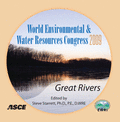Effects of Media Depth on Bioretention Performance in the Upper Coastal Plain of North Carolina and Bioretention Construction Impacts Study
Publication: World Environmental and Water Resources Congress 2009: Great Rivers
Abstract
Bioretention is a principal low impact development (LID) practice. This paper examines two critical questions associated with bioretention design and construction. First, fill media is perhaps the major cost in constructing bioretention cells, so shallower media depths would be preferred, were they to work as well as deeper media systems. Two sets of bioretention cells of varying media depths in the upper coastal plain of North Carolina have been monitored since April 2008. They treat an impervious asphalt parking lot watershed in Nashville, NC. The bioretention cells were constructed with media depths of 0.6 and 0.9 m. Performance is being measured with respect to hydrology and water quality. Data show the deeper media depths meet the LID hydrology goal of volume reduction more frequently (35% compared to 9% of 45 events monitored). The second question examines how bioretention cells are excavated. Two excavation techniques, the conventional "scoop" method which purposefully smears the underlying soil surface and the "rake" method which uses the teeth of an excavator's bucket to scarify the underlying soil surface, were tested. Field tests were conducted on three soil types (sand, loamy sand, and clay) and under a variety of antecedent soil moisture conditions. Saturated hydraulic conductivity, surface infiltration, and soil compaction were measured for each excavated condition. In all cases, the rake method of excavation yielded more permeable, less compacted soils than the scoop method. The difference of infiltration and hydraulic conductivity between the two excavation techniques was statistically significant (p<0.05) when tests were conducted in wet soil conditions. Also, the infiltration rate at the clay site was significantly lower (p<0.05), and the hydraulic conductivity at the sandy site was significantly lower (p<0.05), when the scoop methodology was used. Based on results of this experiment and because there is essentially no extra cost associated with the rake method of excavating bioretention cells, the rake method of excavation is recommended over the conventional scoop method. The use of the rake method is expected to increase long term exfiltration from bioretention cells.
Get full access to this article
View all available purchase options and get full access to this chapter.
Information & Authors
Information
Published In
Copyright
© 2009 American Society of Civil Engineers.
History
Published online: Apr 26, 2012
ASCE Technical Topics:
- Business management
- Coastal engineering
- Coastal plains
- Coasts, oceans, ports, and waterways engineering
- Compacted soils
- Construction engineering
- Construction management
- Construction methods
- Environmental engineering
- Excavation
- Geomechanics
- Geotechnical engineering
- Practice and Profession
- Retention basins
- Soil mechanics
- Soil properties
- Soil water
- Soils (by type)
- Stilling basins
- Sustainable development
- Water treatment
Authors
Metrics & Citations
Metrics
Citations
Download citation
If you have the appropriate software installed, you can download article citation data to the citation manager of your choice. Simply select your manager software from the list below and click Download.
